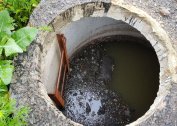The operating rules for the cesspool are established by applicable regulatory documents and are binding. They allow for the disposal of effluents without harming people and nature. On your own site you can build different designs, but they must comply with the requirements. Before you start building your own cesspool, you should learn the features of their arrangement and operation.
Why it is important to handle the cesspool correctly
 A cesspool is the simplest and most common option for the disposal of effluents for private estates, country houses and cottages. The principle of its operation is based on the collection, accumulation and disposal of liquid waste and wastewater, for which special tanks are equipped.
A cesspool is the simplest and most common option for the disposal of effluents for private estates, country houses and cottages. The principle of its operation is based on the collection, accumulation and disposal of liquid waste and wastewater, for which special tanks are equipped.
The design, placement and operation of cesspools are subject to stringent requirements regulated by SNiP and SanPiN. The limitations are well founded. Improper handling of the cesspool can cause serious problems:
- Propagation of pathogenic microorganisms increases the risk of infectious diseases. At the same time, various insects and small rodents carry the infection.
- Bad smell can spread over 10 meters even in calm weather.
- Soil pollution can change its chemical composition, which has a detrimental effect on trees and garden crops.
- When seeping into groundwater, sewage pollutes them, and water appears in the wells that cannot be used as drinking water.
- Moistening the soil has a destructive effect on metal and concrete structures, including foundations of the house and outbuildings.
It should be borne in mind that the operation of cesspools in violation of the norms is not only dangerous for the owners of the plots themselves, but also can poison the lives of neighbors. This is fraught with fair claims and lawsuits.
Given the full degree of danger of effluents, the state tightly controls their disposal in private households and summer cottages. The basis for the norms and requirements was the Law of March 30, 1999 No. 52-FZ “On the Sanitary and Epidemiological Well-Being of the Population”. The basic rules for the maintenance and operation of cesspools are regulated by SanPiN 42-128-4690-88, SP 32.13330.2012, SNiP 30-02-97. Violation of existing norms and rules may be punished by administrative, and sometimes criminal, punishment.
Types of cesspools and their operation
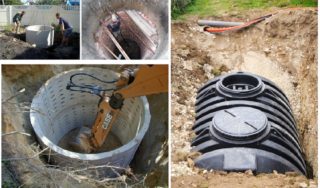 Current regulations allow the use of several designs of cesspools:
Current regulations allow the use of several designs of cesspools:
- Absorbing sumps or cesspools without bottom. This is the simplest design, which is a pit or a well (reservoir), where instead of the bottom a natural filter of sand and gravel is laid. It can be installed provided that the daily flow rate does not exceed 1 cubic meter. In this case, the liquid does not have time to accumulate in the pit (well), but, seeping through the filter layer, goes into the soil.
- Sealed sump. Such a cesspool is made in the form of a well with sealed walls and a bottom. Sewage flows into it by gravity and gradually accumulates. As the volume is filled, mechanical pumping of the liquid is performed.
- Cumulative septic tanks. They are sealed containers (plastic, metal or concrete), in which a filtration and biological treatment system is provided. In such sedimentation tanks, sewage is partially treated, and filtered water does not pose a great danger. With a multi-chamber design, it can be used, for example, for irrigation.
The choice of the type of cesspool depends on the actual volume of runoff, the constancy of residence in the house, soil properties, and the occurrence of groundwater. Special environmental requirements existing in the area must be taken into account.
Each cesspool design requires a specific approach to design, maintenance and operation. It is important to correctly determine the installation location in compliance with all standards, ensure safe and reliable transportation of the runoff, comply with established rules, and clean containers in a timely manner.
Operation of the absorbent structure
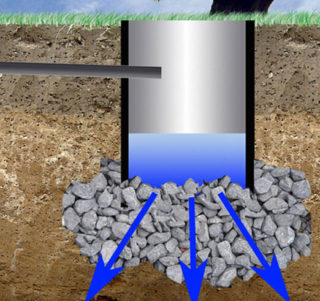 A cesspool without bottom is equipped in accordance with the norms of SanPiN 42-128-4690-88. The bottom filter should contain layers of sand and gravel, as well as a layer of broken stone of various fractions. The bottom of the pit should be located below the level of intake of drinking water in the water well. The distance from the sump to the intake should be at least 20 m in clay soil, 30 m in loam and more than 50 m in sandstone.
A cesspool without bottom is equipped in accordance with the norms of SanPiN 42-128-4690-88. The bottom filter should contain layers of sand and gravel, as well as a layer of broken stone of various fractions. The bottom of the pit should be located below the level of intake of drinking water in the water well. The distance from the sump to the intake should be at least 20 m in clay soil, 30 m in loam and more than 50 m in sandstone.
The following safety distances must be observed:
- to a residential building - 9-10 m, to utility buildings - 5-6 m;
- to the fence and the border with the neighboring section - more than 1 m;
- to the water main - 22-25 m, to the gas route - 5-6 m;
- to trees - 5-6 m.
Wastewater flows by gravity into the cesspool. For this, pipes are laid at a slope of at least 3%. The diameter of the pipe is at least 10 cm.
The natural filter copes with the incoming liquid, but gradually the sludge settles at the bottom, which worsens the filtration. Cleaning the pit from it must be done at least 1 time in 6 months. To do this, the fluid is completely pumped out of the well, and mechanical cleaning is carried out. The top of the well should be closed with a hatch to prevent the spread of odors. Periodic inspection of the pit is provided at least 1 time per week. To do this, the hatch opens and the liquid level is checked, and also with the help of a probe - the state of the bottom filter.
Operation of sealed septic tanks
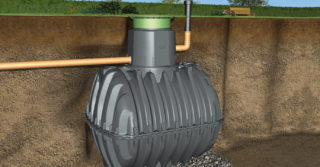 In sealed cesspools of sewage are quite a long time, which allows the development of various bacteria. Chemical reactions and decomposition of substances occur with the release of toxic and combustible gases. This circumstance requires the arrangement of ventilation. Its pipe should have a diameter of at least 10 cm and rise above the ground to a height of more than 0.6 m.
In sealed cesspools of sewage are quite a long time, which allows the development of various bacteria. Chemical reactions and decomposition of substances occur with the release of toxic and combustible gases. This circumstance requires the arrangement of ventilation. Its pipe should have a diameter of at least 10 cm and rise above the ground to a height of more than 0.6 m.
The main parameter is the volume of the filled cavity. It is calculated based on the actual volume of runoff. It is believed that the daily volume on average is 0.5 cubic meters per person. However, with permanent residence and housekeeping, it can reach 2 cubic meters. The calculation is carried out on the condition that pumping is provided after 1-3 months.
An important requirement is the timely pumping of liquid. The level of its accumulation should be constantly monitored. The liquid should not reach the top of the well at a distance of 30 cm. The depth of the pit is not recommended for more than 3 m, which allows the use of standard fecal pumps during pumping. For continuous level monitoring, it is recommended to install a float sensor.
Regulatory documents establish special care for airtight sumps. Regardless of the type of runoff, liquid sterilization is provided at least once every six months. It is designed to eliminate the activity of pathogenic bacteria. For these purposes, it is recommended to use a mixture of bleach, creolin and naphthalisol. It is forbidden to use pure chloride of lime. When it comes into contact with water and some components of the drain, a significant amount of gas is released that can have a dangerous effect on the human respiratory tract.
For the possibility of year-round use of the cesspool, it is necessary to take care of the thermal insulation of the walls of the well and pipes in the trench. It is important to insulate the manhole cover.
Cumulative design
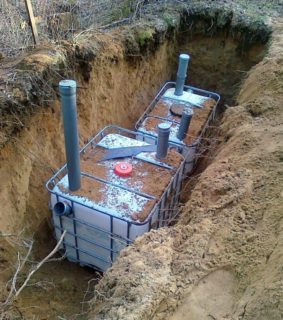 In the storage system an important role is played by a cleaning chamber.In addition to coarse and mechanical filters, biological methods are used. High efficiency is achieved using bioactivators. In fact, these are useful microorganisms that, through their active life, process the remnants of products. Treated waste precipitates and can later be used as fertilizer. To decompose solid waste, special chemicals are introduced into the septic tank.
In the storage system an important role is played by a cleaning chamber.In addition to coarse and mechanical filters, biological methods are used. High efficiency is achieved using bioactivators. In fact, these are useful microorganisms that, through their active life, process the remnants of products. Treated waste precipitates and can later be used as fertilizer. To decompose solid waste, special chemicals are introduced into the septic tank.
Cleaning measures are carried out at least 1 time in 15 days. Every year it is necessary to carry out a full inspection and preventive repair of sealed and storage structures.
When operating cesspools, a situation may arise when their volume ceases to satisfy the owners. In this case, do not rush to dismantle and replace equipment. It is enough to dig another pit nearby, and connect it to an existing one.


